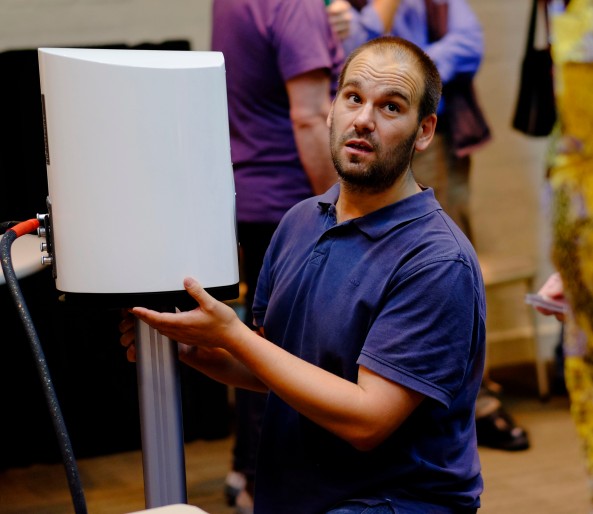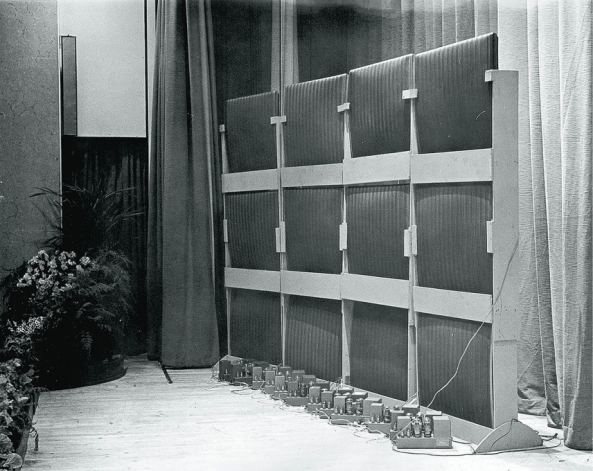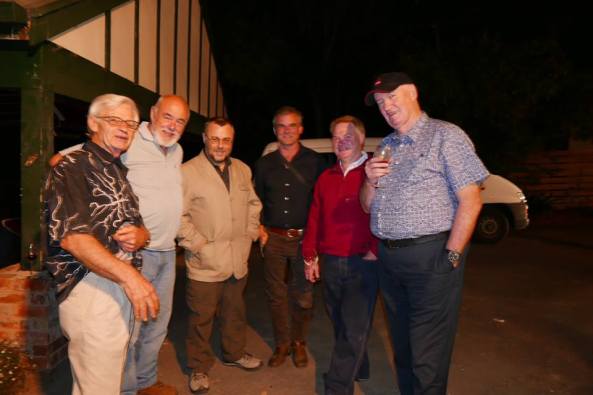With the information that has come to light on the origins of the noval valve form, it is now possible to step into a sweepingly generalized review of the post-WWII miniature receiving valve era.
Immediately post-WWII, RCA and the American industry generally had adopted the B7G miniature as the standard form for small-signal receiving valves, and had introduced a new range accordingly. The B7G had been developed, sized and pinned for smaller-sized battery receivers, but during WWII had been found ideal for VHF applications, from all of the performance, mass-production and cost-of-production viewpoints. The new B7G range covered RF and AF voltage applications and power applications up to 12 W anode dissipation beam tetrodes, although the last-mentioned was seen by some as being a stretch. It also covered AC (6.3-volt heaters) and AC-DC (150 mA heaters) applications, as well as the original battery portables (1.4-volt filaments). Implicit was that higher power applications and also those requiring more than 7 pinouts would continue to use the established octal form. An example of the latter was the RCA 6SB7Y, an improved heptode frequency changer with better performance at 100 MHz than the 6BE6, and released after the latter. Another was the Tung-Sol 6S8GT triple diode-triode, for FM-AM receivers.
On the RF side, the immediate post-WWII B7G valve range was FM-AM radio receiver oriented, although it also covered some TV applications. For the more demanding TV RF and IF applications, the existing WWII-era 6AG5, 6J6 and 6AL5 miniatures sufficed for the time being.
In Europe, Philips had followed a slightly different pathway in respect of miniatures. Whilst acknowledging the B7G base, it developed a larger miniature valve for use in mains-operated receivers. This, the Rimlock (B8A) form, had eight pins to enable it to accommodate the preferred triode-hexode frequency changer, and an envelope size calculated to accommodate a 9 W anode dissipation pentode. At the time Philips indicated that the existing B9G base would be used for the few receiving valves (of the era) that required more than 8 pins, and it was implicit that the octal base would be continued to be used for higher power receiving valves. The Rimlock range covered radio applications, AC (6.3-volt heaters), AC-DC (100 mA heaters), domestic battery (1.4-volt filaments), and one or two TV applications, as with the EF42 and UF42. On a horses-for-courses basis, Philips also adopted the B7G base for battery portable receiver and for industrial applications. The Rimlock type appears to have been developed during the latter part of WWII, as the initial range was announced in 1946. However, it was a couple of years or so before production ran up and the setmakers started using these valves.
The Rimlock form was not widely adopted by the European valve makers, though, and those that did not instead introduced B7G miniatures, both from the American series, and locally developed, the latter including 100 mA series-heater examples.
Meanwhile in the USA, GE (it is assumed) developed and introduced the noval (B9A) type. This was simply the B7G enlarged to accommodate nine pins, with the same pin-to-pin spacing. This then determined the overall dimensions, which turned out to be very similar to those of the Philips Rimlock. In the USA, the noval base was used primarily for valves that required more than seven pins, and very occasionally for those that did not, but whose power dissipation levels were beyond what the B7G envelope could accommodate, but within noval envelope capacity. GE initially focussed on FM and TV applications, with apparent emphasis on the former, its initial release including the 6T8 triple diode-triode and the 12AT7 double triode. RCA may have been ambivalent about the noval, perhaps because of its investment in the B7G miniature. On the one-hand it initially presented the noval as a “fellow-traveller” to the miniature, but on the other hand it saw its advantages, and for example quickly released the 6BA7 heptode frequency changer as a noval version of the still-new octal 6SB7Y. Thereafter, virtually all receiving small-signal applications could be covered by the B7G and noval types, further reducing the remaining applications for the octal type. The American approach was to choose B7G or B9A bases as appropriate for the valve in question, and there were very few duplications. Similarly the setmakers generally accepted the use of mixed B7G and B9A valves as required, rather than standardize on one or the other in a given circuit.
In hindsight one might say that the development of the noval valve or something like it was inevitable. To some extent by happenstance, the B7G form had turned out to have much broader application than that envisaged in its original small battery receiver mission, but ultimately it was constrained by its limited envelope size and limited pin count. Philips had developed the Rimlock with mains-powered domestic applications in mind, and had sized it and pinned it accordingly. One might say that it chose correctly on envelope size, but wrongly on pin count. But the desirability of nine pins, particularly for some FM-AM and TV applications, did not become apparent until after WWII. And when it did, the American valve makers moved very quickly to get the new noval valves into production and into new and updated receiver designs. Of the Rimlock then, one might say “close, but no cigar.” (Or is that phrase non-PC these days?) Still, predicting the future is always a chancy business, and one thinks of the aphorism “he who predicts the future lies even when he tells the truth”. In the late 1940s, given the speed at which the B7G and B9A valves had been adopted and their respective ranges expanded, and noting Raytheon’s Bantal type, an informed observer might have confidently predicted the early arrival of “big” all-glass miniatures that would supplant the octal types in higher power receiving applications. But that didn’t actually happen for more than a decade.
Given its investment in the Rimlock, Philips was surely chagrined at the arrival of the noval, but by no means did it ignore it. In fact, it embraced it. As said, it had postulated the B9G form as the 9-pin companion to the Rimlock, but I don’t think that it had actually released any new B9G-based receiving valves. Effectively then the noval simply replaced the B9G in this role, supplementing but not supplanting (initially anyway) the Rimlocks, an early example being the EBF80. Then for its new TV valve series, Philips chose the noval base as primary. This range was essentially of the 300 mA series-heater type, with as many valves as reasonably possible having dual-use 6.3 volt, 300 mA heaters, and where that was not possible, some duplications in 6.3-volt form. The range also included the B7G EB91, drawn from Philips’ industrial range. That was a small sign that Philips also accepted the American duality of mixing B7G and B9A valves in the same chassis.
The next step for Philips was the set of noval FM-AM radio and audio valves, such as the ECH81, EABC80, ECC83 and EL84, some of which, but not all, needed nine pinouts. The range included the EM80 tuning indicator. This was followed by noval replacements for the remaining “AM-only” Rimlocks, including the EBC81 and EF89. The radio novals also included 100 mA series-heater types, such as the UCH81. So one might say that the exit from the Rimlock type was done quite gracefully under the circumstances.
Those European valve makers who had not adopted Rimlock must have been relieved at the arrival of the noval base, as it enabled them to offer uncompromised triode-hexodes/heptodes. Brimar’s 12AH8 (recorded in WW 1949 November) was an early issue, as was GEC’s X79 (release date unknown to me). But the first mention that I have found of the Philips/Mullard EF80 was in WW 1949 November. I think that the EBF80 preceded it, but I haven’t yet found a release announcement for it.
Meanwhile in the late 1940s Raytheon had introduced the improved “Bantal” form of the octal valve. This did not slow the general conversion to miniatures, but it seems to have been widely adopted and perhaps extended the reign of octals in higher power applications. In the USA, new octal releases for TV applications continued into the early 1960s as far as I know.
Other significant events in the miniature world, although not base-specific, included the introduction of a relatively small number of 12.6-volt heater car radio valves in the USA, supplementing existing series-heater valves that happened to have 12.6-volt heaters, followed by 12-volt HT car radio ranges on both sides of the Atlantic. In the American case, these 12 volt-HT valves had 12.6-volt heaters, whilst in the European case they were mostly 6.3-volt. The Philips range, like the American range, was on a mix of B7G and B9A bases. Following that, in the USA, 600 mA and the 450 mA series-heater valves, with controlled warm-up times, were introduced for TV receiver applications.
Then around 1960-61, the similar-but-slightly-different novar (USA) and magnoval (Europe) forms of “enlarged” nine-pin miniatures appeared, the magnoval apparently being the more successful of the two. These were reserved for higher power applications, such as TV line and field outputs, which were beyond the reach of the noval envelope. One might say that these were belated successors to the octal, presumably easier to mass produce and lower in cost. They shared the same 11/16 inch pin pitch circle as the octal, which I think is indicative of the design intent.
The decar and decal 10-pin bases of the 1960s were effectively sidebars to the noval story.
And all of that does relate to my original question about the EF89 of 6½ years ago, in that it provides a “big picture” map that shows just where the EF89 fitted in. It was part of Philips’ final wave of the “novalization” of small-signal receiving valves, an improved direct replacement for the EF41, and a generally better alternative to the EF85 in FM-AM receiver IF amplifiers, the EF85 having been “borrowed” from Philips’ TV valve series. It also signalled “catch-up” time for European HF remote cutoff pentodes, in that the EF89 more-or-less matched, and possibly slightly improved upon the American 6BA6 in terms of slope and smoothness of the slope curve. Immediately post-WWII, American mainstream practice had taken a step upwards, performance-wise, with the 6BA6, which was designed with FM (100 MHz) applications in mind as well as AM. European practice, as with the EF41, W77, etc., had retained historic HF pentode characteristics. Of course, the 6BA6 was also widely used in Europe.
Perhaps because of the later arrival of FM in Europe, there was never enough of a need to justify adding a sharp cutoff HF pentode in the European noval receiving series. The American series had included the 6AU6 as the sharp cutoff companion to the 6BA6, and widely used as an FM-only IF amplifier and FM limiter. In Europe, when FM arrived, the TV valve series had been established, and it was convenient simply to “borrow” from this the sharp cutoff, high-slope VHF pentodes, such as the EF80 and Z77, for similar FM applications. But as with the 6BA6, the 6AU6 was widely used in Europe.
Cheers,














